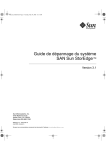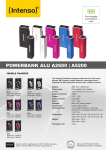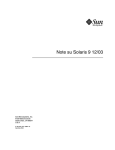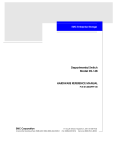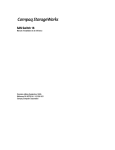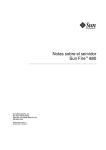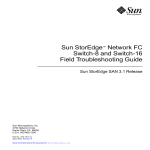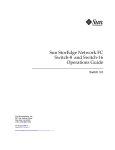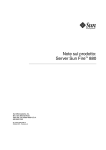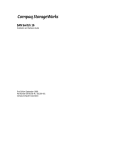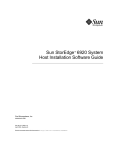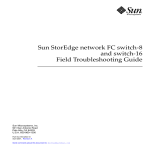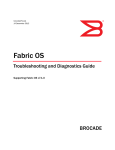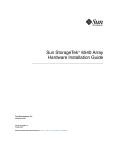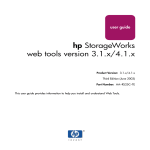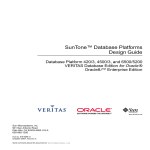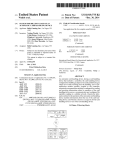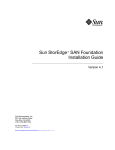Download Sun StorEdge SAN Customer Troubleshooting Guide, Release 3.1
Transcript
Sun StorEdge TM SAN Customer Troubleshooting Guide Release 3.1 Sun Microsystems, Inc. 4150 Network Circle Santa Clara, CA 95054 U.S.A. 650-960-1300 Part No. 816-2953-11 May, 2002 Revision A Send comments about this document to: [email protected] Copyright 2002 Sun Microsystems, Inc., 4150 Network Circle •Santa Clara, CA 95054 USA. All rights reserved. This product or document is protected by copyright and distributed under licenses restricting its use, copying, distribution, and decompilation. No part of this product or document may be reproduced in any form by any means without prior written authorization of Sun and its licensors, if any. Third-party software, including font technology, is copyrighted and licensed from Sun suppliers. Parts of the product may be derived from Berkeley BSD systems, licensed from the University of California. UNIX is a registered trademark in the U.S. and other countries, exclusively licensed through X/Open Company, Ltd. For Netscape Communicator™, the following notice applies: Copyright 1995 Netscape Communications Corporation. All rights reserved. Sun, Sun Microsystems, the Sun logo, AnswerBook2, docs.sun.com, Sun StorEdge network FC switch-8, and Solaris are trademarks, registered trademarks, or service marks of Sun Microsystems, Inc. in the U.S. and other countries. All SPARC trademarks are used under license and are trademarks or registered trademarks of SPARC International, Inc. in the U.S. and other countries. Products bearing SPARC trademarks are based upon an architecture developed by Sun Microsystems, Inc. The OPEN LOOK and Sun™ Graphical User Interface was developed by Sun Microsystems, Inc. for its users and licensees. Sun acknowledges the pioneering efforts of Xerox in researching and developing the concept of visual or graphical user interfaces for the computer industry. Sun holds a non-exclusive license from Xerox to the Xerox Graphical User Interface, which license also covers Sun’s licensees who implement OPEN LOOK GUIs and otherwise comply with Sun’s written license agreements. RESTRICTED RIGHTS: Use, duplication, or disclosure by the U.S. Government is subject to restrictions of FAR 52.227-14(g)(2)(6/87) and FAR 52.227-19(6/87), or DFAR 252.227-7015(b)(6/95) and DFAR 227.7202-3(a). DOCUMENTATION IS PROVIDED “AS IS” AND ALL EXPRESS OR IMPLIED CONDITIONS, REPRESENTATIONS AND WARRANTIES, INCLUDING ANY IMPLIED WARRANTY OF MERCHANTABILITY, FITNESS FOR A PARTICULAR PURPOSE OR NONINFRINGEMENT, ARE DISCLAIMED, EXCEPT TO THE EXTENT THAT SUCH DISCLAIMERS ARE HELD TO BE LEGALLY INVALID. Copyright 2002 Sun Microsystems, Inc., 4150 Network Circle • Santa Clara, CA 95054 Etats-Unis. Tous droits réservés. Ce produit ou document est protégé par un copyright et distribué avec des licences qui en restreignent l’utilisation, la copie, la distribution, et la décompilation. Aucune partie de ce produit ou document ne peut être reproduite sous aucune forme, par quelque moyen que ce soit, sans l’autorisation préalable et écrite de Sun et de ses bailleurs de licence, s’il y en a. Le logiciel détenu par des tiers, et qui comprend la technologie relative aux polices de caractères, est protégé par un copyright et licencié par des fournisseurs de Sun. Des parties de ce produit pourront être dérivées des systèmes Berkeley BSD licenciés par l’Université de Californie. UNIX est une marque déposée aux Etats-Unis et dans d’autres pays et licenciée exclusivement par X/Open Company, Ltd. La notice suivante est applicable à Netscape Communicator™: Copyright 1995 Netscape Communications Corporation. Tous droits réservés. Sun, Sun Microsystems, the Sun logo, AnswerBook2, docs.sun.com, Sun StorEdge network FC switch-8, et Solaris sont des marques de fabrique ou des marques déposées, ou marques de service, de Sun Microsystems, Inc. aux Etats-Unis et dans d’autres pays. Toutes les marques SPARC sont utilisées sous licence et sont des marques de fabrique ou des marques déposées de SPARC International, Inc. aux Etats-Unis et dans d’autres pays. Les produits portant les marques SPARC sont basés sur une architecture développée par Sun Microsystems, Inc. L’interface d’utilisation graphique OPEN LOOK et Sun™ a été développée par Sun Microsystems, Inc. pour ses utilisateurs et licenciés. Sun reconnaît les efforts de pionniers de Xerox pour la recherche et le développement du concept des interfaces d’utilisation visuelle ou graphique pour l’industrie de l’informatique. Sun détient une licence non exclusive de Xerox sur l’interface d’utilisation graphique Xerox, cette licence couvrant également les licenciés de Sun qui mettent en place l’interface d’utilisation graphique OPEN LOOK et qui en outre se conforment aux licences écrites de Sun. CETTE PUBLICATION EST FOURNIE "EN L’ETAT" ET AUCUNE GARANTIE, EXPRESSE OU IMPLICITE, N’EST ACCORDEE, Y COMPRIS DES GARANTIES CONCERNANT LA VALEUR MARCHANDE, L’APTITUDE DE LA PUBLICATION A REPONDRE A UNE UTILISATION PARTICULIERE, OU LE FAIT QU’ELLE NE SOIT PAS CONTREFAISANTE DE PRODUIT DE TIERS. CE DENI DE GARANTIE NE S’APPLIQUERAIT PAS, DANS LA MESURE OU IL SERAIT TENU JURIDIQUEMENT NUL ET NON AVENU. Please Recycle Contents Useful Websites ix Useful Email Aliases ix Links to Sun Download Center for software packages Related Sun Documentation Scope Features ix x 1 2 Fabric Ports 2 Translative Loop 3 Name Server Zoning Cascading (T Ports) cfgadm_fp Examples 3 4 4 5 Sun StorEdge Traffic Manager Path States 6 6 Sun StorEdge SAN release 3.1 Features for Sun StorEdge Traffic Manager 7 Sun StorEdge Network FC Switch-8 and Switch-16 Supported Configurations Hosts 11 11 Host/Operating Envrironment Rules 12 iii Arrays 12 Supported Host Bus Adapters Supported Hardware 13 Brocade Supported Configurations QuickLoop 12 14 16 Packages and Patches Array Storage Rules 17 19 Fibre Channel (FC) Tape Libraries Switch Port Types Zones 20 21 21 Hard Zones 21 Name Server Zones SL Zones 21 22 Zoning Rules 23 Cascading Rules 23 Rules for Adding and Removing Devices While the Hosts are Online 23 Guidelines for Configuration Switches 24 24 Zones and Arrays 24 Zones and Storage 24 Configuration Examples 26 Single Host Connected to One Storage Array 26 Single Host Connected to Multiple Storage Arrays Multihost 28 35 Sun StorEdge Network FC Switch-8 and Switch-16 Switch Diagnostic Tools Storage Automated Diagnostic Environment 43 Storage Automated Diagnostic Environment Functions iv Troubleshooting for the Sun StorEdge SAN Release 3.1 • May 2002 44 43 Storage Automated Diagnostic Environment Agent Functionality 44 Storage Automated Diagnostic Environment Diagnostic Functionality 46 Running Diagnostic Tests From the GUI Window ▼ To Access the Diagnostic Tests 47 Sansurfer GUI 2.08.22 or above (SUNWsmgr) Other Tools 46 49 50 Sun Explorer Data Collector (SUNWexplo) and T3Extractor Capture and Sanbox API 50 Storage Automated Diagnostic Environment and Brocade brocadetest(1M) 51 52 Other Diagnostic Tools supportShow ▼ 50 53 53 To Access the Brocade Silkworm Switch 58 Port Differences between Sun StorEdge Ports and Brocade Ports Sun StorEdge Network FC Switch Setup Requirements Troubleshooting Steps Brocade Silkworm Switch 60 61 61 62 64 Contents v vi Troubleshooting for the Sun StorEdge SAN Release 3.1 • May 2002 Preface This document provides guidance for locating and troubleshooting problems for the Sun StorEdge network FC switches and Brocade Silkworm Fibre Channel switches. Refer to the Sun Network Storage Product Page at http://www.sun.com/ storage/san/ for the most recent product information and recent product patches. News about changes to SAN-supported configurations and product update patches are available at this site. Copies of product documentation are also available here. The Sun StorEdge network FC switches operate with three Sun StorEdge storage platforms: the Sun StorEdge A3500FC array, the Sun StorEdge A5200 array, and the Sun StorEdge T3 array. Check SunSolve.sun.com for current patch levels on your storage platforms. Using UNIX Commands This document may not contain information on basic UNIX® commands and procedures such as shutting down the system, booting the system, and configuring devices. See one or more of the following for this information: ■ Solaris Handbook for Sun Peripherals ■ AnswerBook2™ online documentation for the Solaris™ operating environment ■ Other software documentation that you received with your system vii Typographic Conventions Typeface Meaning Examples AaBbCc123 The names of commands, files, and directories; on-screen computer output Edit your .login file. Use ls -a to list all files. % You have mail. AaBbCc123 What you type, when contrasted with on-screen computer output % su Password: AaBbCc123 Book titles, new words or terms, words to be emphasized Read Chapter 6 in the User’s Guide. These are called class options. You must be superuser to do this. Command-line variable; replace with a real name or value To delete a file, type rm filename. Shell Prompts viii Shell Prompt C shell machine_name% C shell superuser machine_name# Bourne shell and Korn shell $ Bourne shell and Korn shell superuser # Troubleshooting for the Sun StorEdge SAN Release 3.1 • May 2002 Useful Websites http://cpre-amer.west/nws/ Customer Problem Resolution Engineering site for the Sun StorEdge T3 Array http://sse.ebay.sun.com/interop SAN Interoperability Homepage and Interoperability Support Matrix http://www.sun.com/storage/san External Sun SAN program website Useful Email Aliases ■ t3mps@east - Sun StorEdge T3 Array Multiplatform support ■ purple-support@west - General Sun StorEdge T3 Array support ■ switch-support@west - Sun StorEdge Fibre Channel Switch support Links to Sun Download Center for software packages http://www.sun.com/storage/t3/nonsun_support.html For Multiplatform Failover Drivers http://www.sun.com/storage/san For SAN packages and documentation Preface ix Related Sun Documentation Product Application Title Part Number SANbox Installer/User’s information SANbox-16STD Fibre Channel Switch Installer’s/User’s Manual 875-3141-10 SANbox-8 Fibre Channel Switch Installer’s/User’s Manual 875-3142-10 SANbox 8/16 Switch Management User’s Manual SANbox 8/16 Switch Management User’s Manual Sun StorEdge Network FC Switch-8 and Switch-16 Release Notes1 875-3060-10 Latest Information Sun StorEdge A5000 Product Notes1 Sun StorEdge T3 Disk Tray Release1 Notes 805-1018-13 806-1497-12 Late news - Best Practices Sun StorEdge A3x00/A3500 FC Best Practices Guide 806-6419-10 Latest Information Sun StorEdge A3500FC Release Notes1 805-7758-11 Sun StorEdge T3 Array/ Switch Sun StorEdge T3Array to Sun StorEdge Network FC Switch Configuration Guide 816-2096-10 Traffic Management Sun StorEdge Traffic Manager Installation and Configuration Guide 816-1420-10 Hub information Sun StorEdge FC-100 Hub Installation and Service Manual 805-0315-12 Storage Cabinet Rackmount information Online Rackmount Placement Matrix 805-4748-xx Software RAID software RAID Manager 6.22 User's Guide 806-0478-10 manpage cfgadm utility cfgadm_fp Latest Information Software Arrays Other Components 1. Check for the latest updates at http://sunsolve.sun.com. x Troubleshooting for the Sun StorEdge SAN Release 3.1 • May 2002 875-3143-10 816-0842-10 Accessing Sun Documentation Online A broad selection of Sun system documentation is located at: http://www.sun.com/products-n-solutions/hardware/docs A complete set of Solaris documentation and many other titles are located at: http://docs.sun.com Sun Welcomes Your Comments Sun is interested in improving its documentation and welcomes your comments and suggestions. You can email your comments to Sun at: [email protected] Please include the part number (for example, 816-2953-10) of your document in the subject line of your email. Preface xi xii Troubleshooting for the Sun StorEdge SAN Release 3.1 • May 2002 CHAPTER 1 Introduction Scope The scope of this document includes the switch and interconnections (HBA, GBIC, cables) on either side of the switch, as shown in the following diagram. Switch Storage Host Switch FIGURE 1-1 Switch and Interconnections 1 This troubleshooting guide is intended to provide basic guidelines that can be used for isolating problems for supported configurations identified in the Sun StorEdge SAN release 3.1 Installation and Configuration guide. T The Storage Automated Diagnostic Environment software package is required to support the configurations in this document. Additional information and resources are available at http://www.sun.com/storage/san or http://sunsolve.sun.com. These websites contain information on software versions and provide necessary patches. Features This release of the Sun StorEdge SAN has many new features. This section lists the major changes and gives a brief description of each. Fabric Ports All ports on the switch are capable of being configured as fabric ports. This allows public devices to connect to the switch. Currently, Sun supports only the host bus adapters, running the correct version of FCODE and Leadville driver stack, to be configured as F Ports. No storage can be configured on a fabric port. Also, the switch will handle host bus adapters being connected via FL-Ports (Public Loop), which is currently not supported. The only supported configuration is F Ports (point-to-point) for public host bus adapters. It should be noted that the switch default setting is FLPort and therefore must be changed at the time of installation to the supported FPort for HBAs. Fabric ports register with the name server on the switch. You can still configure the host bus adapters as private loop devices. By placing the switch port into SL-Port mode, the host bus adapter will configure itself as a private loop device, able to be zoned with other private loop only devices; for example, Sun StorEdge A5200 arrays or Sun StorEdge A3500FC arrays. 2 Troubleshooting for the Sun StorEdge SAN Release 3.1 • May 2002 Translative Loop Translative Loop Ports (TL Ports) allow private loop devices to communicate to offloop devices, such as host bus adapters connected to F Ports and private devices on other TL Ports. You can achieve this connectivity by having a translation function at each TL Port, which translates private frames to public frames and vice versa. ■ Devices connected to TL Ports are registered with the name server on the switch. ■ Devices connected to TL Ports cannot communicate with devices on SL Ports. In the current phase, only the Sun StorEdge T3 array is supported on TL Ports. Refer to the SANbox-8 Fibre Channel Switch Installer’s and User’s Manual, rev. 5 for more information. Name Server Zoning Name server zones allow the division of the fabric (one or more switch chassis) into as many as 256 fabric-wide zones that define which ports or devices receive name server information. If hard zones are enabled, name server zones will not communicate across hard zone boundaries. ■ A name server zone is only valid if enabled. ■ Only ports that register with the name server can be in a name server zone (that is, F/FL Ports and TL Ports). ■ If name server zones are used on a switch in which hard zones are defined, the name server zones must not overlap hard zone boundaries. ■ Name server zones operate fabric-wide (regardless of fabric configuration, but within hard zone boundaries). ■ There is a maximum of 256 name server zones with a maximum of 16 name server zones per hard zone. ■ The switch allows ports to be in more than one name server zone; however, this is not supported in this phase. ■ When a port receives name server information, it will receive information about all ports in the name server zone in which the port is assigned. ■ All ports not defined as being part of any enabled name server zone are name server zone orphans. Name server zone orphans are all listed in the Name Server Orphan Zone. Chapter 1 Introduction 3 Cascading (T Ports) In the Sun StorEdge SAN release 3.1, switches are allowed to be cascaded together. Cascading is allowed with either shortwave or longwave GBICs. Use of shortwave GBICs allows a higher port count in a local configuration. The use of longwave GBICs and long haul fiber optics allows users to reach geographically separated storage and servers, perhaps for disaster recovery purposes. T Ports (Trunking Ports) provide the switch-to-switch connections. Any F or FL port is capable of being configured as a T Port, once the physical connection is made. No user intervention is required, other than ensuring the port type is either F or FL before connecting the switches. You can cascade a maximum of two switches with one ISL hop between the initiator and target, with distances of 10 meters and 10 kilometers. ISL hops do not include the connections between hosts and switches or between switches and storage. For further information, please refer to the Sun StorEdge Network FC Switch-8 and Switch-16 Configuration Supplement—Disaster Tolerant Configurations, 816-3652-10. cfgadm_fp In order to have fabric devices seen by the operating system, they must be configured through the cfgadm framework. A fabric plug-in to cfgadm is used to attach fabric (public) devices. Private loop devices are still configured by the Leadville driver and require no user intervention. 4 Troubleshooting for the Sun StorEdge SAN Release 3.1 • May 2002 Examples # cfgadm -al Ap_Id c0 c0::dsk/c0t0d0 c0::dsk/c0t1d0 c1 c1::dsk/c1t6d0 c2 c2::210000e08b030926 c2::50020f23000003d5 c3 c3::210000e08b032901 c3::50020f23000003c5 Type scsi-bus disk disk scsi-bus CD-ROM fc-fabric unknown disk fc-fabric unknown disk Receptacle connected connected connected connected connected connected connected connected connected connected connected Occupant configured configured configured configured configured unconfigured unconfigured unconfigured unconfigured unconfigured unconfigured Condition unknown unknown unknown unknown unknown unknown unknown unknown unknown unknown unknown A Sun StorEdge T3 array partner pair is connected and showing up on c2 and c3. Currently, the Sun StorEdge T3 arrays are unconfigured, and not available to Solaris. # cfgadm -c configure c2::50020f23000003d5 # cfgadm -al Ap_Id c0 c0::dsk/c0t0d0 c0::dsk/c0t1d0 c1 c1::dsk/c1t6d0 c2 c2::210000e08b030926 c2::50020f23000003d5 c3 c3::210000e08b032901 c3::50020f23000003c5 Type scsi-bus disk disk scsi-bus CD-ROM fc-fabric unknown disk fc-fabric unknown disk Receptacle connected connected connected connected connected connected connected connected connected connected connected Occupant configured configured configured configured configured configured unconfigured configured unconfigured unconfigured unconfigured Condition unknown unknown unknown unknown unknown unknown unknown unknown unknown unknown unknown Chapter 1 Introduction 5 Multiple controllers can be configured in the same command line to save time. # cfgadm -c configure c2 c3 Unconfiguring devices is similar. # cfgadm -c unconfigure c2 c3 See the Sun StorEdge SAN release 3.1 Installation and Configuration Guide or the cfgadm_fp(1M) manpage for further details. Sun StorEdge Traffic Manager Sun StorEdge Traffic Manager provides N-way multipath access to I/O devices, as well as path management capabilities. Sun StorEdge Traffic Manager is released as a component of Solaris. The fundamental change that Sun StorEdge Traffic Manager delivers is to restructure the device tree to permit a multipath device to be represented as a single device instance in Solaris. Sun StorEdge Traffic Manager has various path states to show how the system is currently running. ■ Primary Path: Path to LUN/disk through controller that it resides on. ■ Secondary Path: Path to LUN/disk through alternate controller Path States ONLINE Path is available and will be used for I/O STANDBY Path is available, but will not be used for I/O OFFLINE Path is unavailable Note – Currently, only the Sun StorEdge array uses the ONLINE/STANDBY convention. The Sun StorEdge A5200 array has an ONLINE/ONLINE state. 6 Troubleshooting for the Sun StorEdge SAN Release 3.1 • May 2002 Both paths in a dual connected Sun StorEdge A5200 array will be used for I/O. However, there is currently no way to manually failover a Sun StorEdge A5200 array to use another path. Sun StorEdge Traffic Manager is currently not supported for the Sun StorEdge A3500FC array. Sun StorEdge SAN release 3.1 Features for Sun StorEdge Traffic Manager ■ ■ ■ ■ ■ ■ ■ Dynamic N-Path multipathing with automatic discovery of new paths Support for Sun StorEdge T3 arrays and Sun StorEdge A5200 arrays (no Sun StorEdge A3500FC support) Automatic failover Enable/Disable globally, or per HBA luxadm changes to display multipathing information and manual failover/failback cfgadm(1M) support Dynamic reconfiguration Sun StorEdge Traffic Manager may be enabled/disabled globally, through the /kernel/drv/scsi_vhci.conf file, or on a per host bus adapter port basis, through the /kernel/drv/qlc.conf file. CODE EXAMPLE 1-1 /kernel/drv/scsi_vhci.conf Copyright (c) 2001 by Sun Microsystems, Inc. All rights reserved.# pragma ident "@(#)scsi_vhci.conf 1.2 01/03/19 SMI" name="scsi_vhci" class="root"; Sun StorEdge Traffic Manager Global enable/disable configuration possible values are Sun StorEdge Traffic Manager-disable="no" or Sun StorEdge Traffic Manager-disable="yes" Sun StorEdge Traffic Manager-disable="no"; Load Balancing global configuration possible values are load-balance="none" or load-balance="round-robin" load-balance="round-robin"; Chapter 1 Introduction 7 For individual host bus adapter control, first retrieve a list of Fibre Channel adapters on the host. # ls -l /dev/fc total 12 lrwxrwxrwx 1 root root 49 May 3 15:43 fp0 ../../devices/pci@6,4000/SUNW,qlc@2/fp@0,0:devctl lrwxrwxrwx 1 root root 49 May 3 15:43 fp1 ../../devices/pci@6,4000/SUNW,qlc@3/fp@0,0:devctl lrwxrwxrwx 1 root root 55 May 3 15:43 fp2 ../../devices/pci@6,4000/pci@4/SUNW,qlc@4/fp@0,0:devctl lrwxrwxrwx 1 root root 55 May 3 15:43 fp3 ../../devices/pci@6,4000/pci@4/SUNW,qlc@5/fp@0,0:devctl lrwxrwxrwx 1 root other 55 May 10 11:56 fp4 ../../devices/pci@6,2000/pci@1/SUNW,qlc@4/fp@0,0:devctl lrwxrwxrwx 1 root other 55 May 10 11:56 fp5 ../../devices/pci@6,2000/pci@1/SUNW,qlc@5/fp@0,0:devctl -> -> -> -> -> -> Then modify the /kernel/drv/qlc.conf file as shown in the example. name="qlc" parent="/pci@6,4000" unit-addres="2" Sun StorEdge Traffic Manager-disable= "yes" This would disable the single port HBA denoted (in this example) by fp0. To disable one port on a dual port card (denoted by fp2-fp5): name="qlc" parent="/pci@6,2000/pci@1" unit-address="5" Sun StorEdge Traffic Managerdisable="yes" This would disable the HBA port denoted by fp5. A T3 lun with Sun StorEdge Traffic Manager enabled would look similar to this: CODE EXAMPLE 1-2 ls -l /dev/rdskc6t60020F20000003C53ABF4A1C000915F4d0s2 -> ../../devices/scsi_vhci/ssd@g60020f20000003c53abf4a1c000915f4:c,raw 8 Troubleshooting for the Sun StorEdge SAN Release 3.1 • May 2002 # luxadm display /dev/rdsk/c6t60020F20000003C53ABF4A1C000915F4d0s2 DEVICE PROPERTIES for disk: /dev/rdsk/c6t60020F20000003C53ABF4A1C000915F4d0s2 Status(Port A): O.K. Status(Port B): O.K. Vendor: SUN Product ID: T300 WWN(Node): 50020f20000003c5 WWN(Port A): 50020f23000003c5 WWN(Port B): 50020f23000003d5 Revision: 0117 Serial Num: 096510 Unformatted capacity: 119514.500 MBytes Write Cache: Enabled Read Cache: Enabled Minimum prefetch: 0x0 Maximum prefetch: 0x0 Device Type: Disk device Path(s): /dev/rdsk/c6t60020F20000003C53ABF4A1C000915F4d0s2 /devices/scsi_vhci/ssd@g60020f20000003c53abf4a1c000915f4:c,raw Controller /devices/pci@6,4000/SUNW,qlc@2/fp@0,0 Device Address 50020f23000003d5,0 Class secondary State STANDBY Controller /devices/pci@6,4000/SUNW,qlc@3/fp@0,0 Device Address 50020f23000003c5,0 Class primary State ONLINE It would have two physical paths associated with it as well. Note the Controller lines. Also note the primary/secondary paths, as well as the STANDBY/ONLINE states. Chapter 1 Introduction 9 A Sun StorEdge A5200 array disk would look similar to the following example. In the case of A5200s, both paths are primary and ONLINE. # luxadm display /dev/rdsk/c6t200000203719EB58d0s2 DEVICE PROPERTIES for disk: /dev/rdsk/c6t200000203719EB58d0s2 Status(Port A): O.K. Status(Port B): O.K. Vendor: SEAGATE Product ID: ST39103FCSUN9.0G WWN(Node): 200000203719eb58 WWN(Port A): 210000203719eb58 WWN(Port B): 220000203719eb58 Revision: 034A Serial Num: LS4563930000 Unformatted capacity: 8637.338 MBytes Read Cache: Enabled Minimum prefetch: 0x0 Maximum prefetch: 0xffff Location: In the enclosure named: DPL4 Device Type: Disk device Path(s): /dev/rdsk/c6t200000203719EB58d0s2 /devices/scsi_vhci/ssd@g200000203719eb58:c,raw Controller /devices/pci@6,2000/pci@1/SUNW,qlc@5/fp@0,0 Device Address 220000203719eb58,0 Class primary State ONLINE Controller /devices/pci@6,2000/pci@1/SUNW,qlc@4/fp@0,0 Device Address 210000203719eb58,0 Class primary State ONLINE Refer to the Sun StorEdge Traffic Manager Installation and Configuration Guide for further details on installing and administering Sun StorEdge Traffic Manager. 10 Troubleshooting for the Sun StorEdge SAN Release 3.1 • May 2002 CHAPTER 2 Configurations This chapter contains information and instructions for configuring your Sun StorEdge or Brocade Silkworm switches with one or more hosts and storage. Sun StorEdge Network FC Switch-8 and Switch-16 Supported Configurations To support a high-availability environment, use these configurations to ensure switch redundancy. See the example diagrams later in this chapter for more information on the supported configurations. Hosts ■ Sun Enterprise™ E220R, E250, E420R, and E450 server hosts ■ Sun Enterprise E10000 server host ■ Sun Enterprise E3000-E6000 server hosts ■ Sun Enterprise E3500-E6500 server hosts ■ Sun Enterprise F3800 server host (only with the Sun StorEdge CPCI Dual Fibre Channel Adapter) ■ Sun Enterprise F4810 server host ■ Sun Enterprise F6800 server host 11 Host/Operating Envrironment Rules ■ All hosts in a zone must be running Solaris 8 , upgrade 6, Release 10/01 operating environment with all appropriate patches installed. You can download the patches from Sunsolve. ■ Mixing PCI Dual Fibre Channel Network Adapter and PCI single Fibre Channel Network Adapter HBAs in the same switch zone is supported. ■ Mixing an Sbus host (with a PCI card) and PCI hosts within the same zone is supported. You must be using PCI dual Fibre Channel Network Adapter and PCI single Fibre Channel Network Adapter HBAs. Arrays ■ Sun StorEdge A5200 array ■ Sun StorEdge T3 array ■ Sun StorEdge A3500FC array Supported Host Bus Adapters 12 ■ PCI Single Fibre Channel network adapter ■ PCI Dual Fibre Channel network adapter ■ CPCI Dual Fibre Channel network adapter Troubleshooting for the Sun StorEdge SAN Release 3.1 • May l 2002 Supported Hardware In a single switch configuration, the switch is connected to the host through a fiber optic cable to a Sun StorEdge PCI Fibre Channel Network Adapter. The other ports of the switch are connected to storage devices through a fiber optic cable. In a cascaded configuration, two switches are connected together by way of InterSwitchLinks (ISL). A hard zone and a name server zone span both switches. TABLE 2-1 Supported Hardware Part Number Description 540-4026 Sun StorEdge A3500FC FC-AL controller for Sun StorEdge A3500FC Array (with Sun StorEdge D1000 tray) 540-4027 Sun StorEdge A3500FC FC-AL controller for Sun StorEdge A3000 array (with Sun StorEdge RSM tray) 950-3475 Sun StorEdge T3 Array X4748A Sun StorEdge PCI Dual Fibre Channel Network Adapter X6727A Sun StorEdge PCI Dual Fibre Channel Network Adapter+ x6799A Sun StorEdge PCI Single Fibre Channel Network Adapter Sun StorEdge CPCI Dual Fibre Channel Network Adapter X6731A Gigabit Interface Converter (GBIC) X7637A Long Wave (LW) GBIC X978A 15m fiber optic cable X6746A Sun StorEdge FC switch-8 Switch SG-XSW16-32P Sun StorEdge network FC switch-16 Switch Sun StorEdge L180 Tape Library with StorageTek 9840 tape drives Sun StorEdge L700 Tape Library with StorageTek 9840 tape drives Chapter 2 Configurations 13 Brocade Supported Configurations The Brocade Silkworm switch configurations and the Sun switch configurations follow the same rules for maximum number of initiators, supported number of arrays per zone, and other hardware-specific information. Brocade Silkworm switch configurations and Sun switch configurations have different minimum operating system (OS) and patch requirements, shown in TABLE 2-2. TABLE 2-2 SAN Supportability Matrix Sun Multipath Driver Host OS OS Level Patches or Service Pack Patches: Recommended security patches. Server Type Sun: Solaris Leadville unbundled packages: SUNWsan SUNWcfpl SUNWcfplx HBA Firmware Amber x6799A 1.13 Crystal+ x6727A 1.13 1.13 Ex80R Diamond x6748A Ex500 Ivory x6757A 1.13.06 Ex20 Ex50 8 u6 (10/01) HBAs Patches Leadville 5C 111095-07 111096-03 111097-07 111412-07 Fx800 111413-07 F4810 111846-03 E10000 111847-01 Volume Manager 3.2 111904-04 111909-04 14 Troubleshooting for the Sun StorEdge SAN Release 3.1 • May l 2002 TABLE 2-3 Disk Array Supportability Matrix Dynamic addition of target to a zone. Host Solaris 8 Disk Arrays Disk Firmware Add First/Additional Max targets per zone T3A WG/ES 1.18 Yes/Yes 8/4 T3B WG/ES 2.01 Yes/Yes 8/4 A3500FC 03.01.03.54 or later No/Yes 4 FC Tape L180 Drive Firmware StorageTek 9840: Rev. 28.127 No/Yes 4 TABLE 2-4 Host Solaris 8 Fibre Channel Switch Supportability Matrix FC Switches Firmware Switch Software Licenses Brocade Silkworm 2400 v2.6.0a Fabric OS v2.6.0a Zoning Quickloop Webtools Brocade Silkworm 2800 v2.6.0a Fabric OS v2.6.0a Zoning Quickloop Webtools Brocade Silkworm 3800 v3.0.2a Fabric OS v3.0.2a Zoning Quickloop Webtools Notes: 1. Brocade Silkworm 3800 FC Switches are supported in 1 GB mode only. 2. Brocade Silkworm 2400, 2800, and 3800 FC Switches may be intermixed. Interoperability with other vendor switches is not supported at this time. TABLE 2-5 Applications/Utilities Supportability Matrix Name Version Patches VERITAS Volume Manager 3.2 GA 111413-05, 111904-04, 111909-04 SUNWstade 2.0 112580-01 Chapter 2 Configurations 15 QuickLoop QuickLoop (QL) is a feature of the Brocade Silkworm switches that allows hosts with host bus adapters (HBAs) that are not fully Fabric-aware to communicate with other devices attached to the switch. In addition, QL allows switches to replace hubs in a private loop environment. QL is a separately licensed product. Note – For the Brocade Sun StorEdge SAN 3.1 phase, Sun StorEdge A5200 arrays and Sun StorEdge A3500FC arrays still need to be configured as a Quickloop port. Sun StorEdge T3 arrays do not need Quickloop, nor do Host Bus Adapters. Sun StorEdge T3 arrays will autoconfigure as L Ports and HBAs will autoconfigure as F Ports. Features 16 ■ A maximum of 126 devices are allowed within a single QL. ■ Ports (looplets) of up to two switches can be included in a QL. ■ Each looplet supports transfer rates of up to 100 MB/sec and multiple, concurrent transfers can occur in multiple looplets. ■ Hosts that are attached to QL can communicate to all devices in the same QL. ■ Other public hosts can communicate to all devices in QL. ■ Individual QL ports can be converted to a Fabric Loop Attach (FLA) compliant FL_Ports by disabling the QL mode on that port Troubleshooting for the Sun StorEdge SAN Release 3.1 • May l 2002 Packages and Patches The packages and patches found in TABLE 2-6 are mandatory and must be installed in the order listed. The assumption is that you are starting from an updated Solaris 8 (update 6, 10/01) installation. Refer to the most current Sun StorEdge SAN release 3.1 Release Notes and Sunsolve for the most recent patches and packages beyond the levels listed below. TABLE 2-6 Solaris 8 6/01 Minimum Required Packages and Patches Patch or Package Solaris 8 Recommended and Security Patches SUNWsan SAN Foundation package SUNWcfpl cfgadm plug-in 32-bit package SUNWcfplx cfgadm plug-in 64-bit package 111412-07 Sun StorEdge Traffic Manager patch 111095-07 fcp/fp/fc1t/usoc drivers patch 111096-03 fcip driver patch 111097-07 qlc driver patch 111413-07 luxadm/libg_fc/liba5k patch 111846-03 cfgadm_fp plugin patch 111847-01 SANWsan patch; SAN Foundation Kit patch SUNWstade 112580-01 Storage Automated Diagnostic Environment package Brocade patch SUNWsmgr SANsurfer Switch Manager 2.08.22 package (Sun switches only) 111096-03 SANsurfer patch (Sun switches only) Chapter 2 Configurations 17 Unbundled Software For a list of unbundled software, refer to TABLE 2-7. TABLE 2-7 Unbundled Software Package Minimum Revision Minimum Patch (if any) RAID Manager RM6 6.22 108553-09 Solstice Disk Suite 4.2.1 108693-04 Component Manager 2.2 T3 Firmware 1.17b See Early Notifier #14838 Switch Firmware 3.04.60 111096-03 SANsurfer GUI 2.08.30 111096-03 JAVA SDK/JDK 1.3.02 PCI Single FC Host 1.12 See Early Notifier #14838 1.12 See Early Notifier #14838 Adapter Fcode (x6799a) PCI Dual FC Host Adapter Fcode (x6727a) 18 StorageTek 9840 1.28.126 T3 Firmware 1.17b VERITAS Volume Manager 3.1.1 (SL Zones Only) 3.2 (Fabric) VERITAS File System 3.4 Instant Image 3.0 SNDR 3.0 Alternate Pathing 2.3.1 110722-01 110432-04 Storage Automated Diagnostic Environment 2.0 T112580-01 (Brocade support) VERITAS Netbackup 3.4 110539-04 Solstice Backup 6.0 Sun Enterprise 3x00/4x00/5x00/6x00 Flash Prom 3.2.28 Troubleshooting for the Sun StorEdge SAN Release 3.1 • May l 2002 111118-02 103346-29 TABLE 2-7 Unbundled Software Sun Fire 3800/4800/4810/6800 Flash Prom 5.11.6 111346-02 E450 Flash Prom 3.22.0 106122-09 E250 Flash Prom 3.22.0 106530-06 E420R Flash Prom 3.29.0 109082-04 Note – The packages and/or patches listed in TABLE 2-7 may not be present in all configurations. Array Storage Rules The following tables specify the supported features of the Sun StorEdge T3 array, and the Sun StorEdge A3500FC array. TABLE 2-8 Supported Features of the Sun StorEdge T3 Array Feature Supported Cascading Yes Zone Type Name Server zone1, SL zone Maximum number of arrays per SL zone 8 Maximum initiators per LUN 2 Maximum initiators per zone 22 1. The host must be connected to the F-Port on the switch; Sun StorEdge T3 array must be connected to the TL port of the switch. 2. This implies 2 initiators (2 hosts) for simple arrays (T3WG), but 4 initiators (2 hosts) for a partner pair (T3ES). Eash host has one path to each of the Sun StorEdge T3 arrays in the partner pair. Chapter 2 Configurations 19 The Sun StorEdge A3500FC array is not supported on a host that has the Sun StorEdge Traffic Manager enabled with Sun StorEdge Traffic Manager-supported devices or has Fabric devices connected. TABLE 2-9 Supported Features of the Sun StorEdge A3500FC Array Feature Supported Cascading No Zone Type SL zone only Maximum number of arrays per SL zone 4 Maximum initiators per SL zone 2 TABLE 2-10 Supported Features of Network-Attached Storage and SNDR Supported Cascading Fabric name server zone Zone Type Fabric name server zone (HBA as F-Port ptto-pt) Maximum device ports per zone 81,2 1. With the PCI dual Fibre Channel Network Adapter+ HBA, only physical port 2 can be used for FCIP. 2. With the CPCI Dual Fibre Channel Network Adapter HBA, only physical port 1 can be used for FCIP. Fibre Channel (FC) Tape Libraries Both the L180 and L700 FC Tape Libraries require StorageTek 9840 FC tape drives. You must upgrade to the most recent software for each L180 or L700 FC-Tape unit. You can configure either the Sun StorEdge L180 or L700 Tape Library with a switch. 20 ■ The Sun StorEdge L180 Tape Library requires one 16-port switch, configured as two 8-port zones ■ The Sun StorEdge L700 requires a minimum of one 8-port switch and one 16-port switch ■ The switch may be zoned to allow up to four hosts per zone ■ You can configure a maximum of three StorageTek 9840FC drives per zone ■ A library may share a zone with up to three drives ■ A single zone cannot have more than one tape library Troubleshooting for the Sun StorEdge SAN Release 3.1 • May l 2002 Switch Port Types Port Type Supported SL Ports Private loop (Sun StorEdge A5200 array, Sun StorEdge A3500FC array, Sun StorEdge T3 array, L180 or L700 FC-Tape device) TL Ports Translated loop (Sun StorEdge T3 array) F Ports Point-to-Point fabric (HBA) T Ports Trunk ports for switch cascading (ISLs) configured initially in Fabric port mode Zones Zoning allows the user to divide the switch ports into zones for more efficient and secure communication among functionally grouped nodes. There are several types of zones and a port may be defined in any. No port can be in all zone types simultaneously. Hard Zones Hard zones isolate ports through internal switch hardware; no communication across hard zone boundaries is possible. Hard zoning provides a way of isolating a set of ports from other ports within the fabric, desirable for security and resource dedication. Up to sixteen hard zones are possible within a fabric. A particular port may be placed in only one hard zone (no overlapping hard zones). If hard zones are enabled, name server zones and SL zones do not communicate across defined hard zone boundaries. Name Server Zones Name server zones allow the division of the fabric (one or more Switch chasses) into as many as 256 fabric-wide zones; each name server zone defines which ports or devices receive name server information, as defined by the FC-GS3 document. If hard zones are enabled, name server zones do not communicate across defined hard zone boundaries. Up to 16 name server zones are possible within one hard zone. Chapter 2 Configurations 21 SL Zones SL zones on the switch allow the division of the fabric into zones that define the ports that can communicate with each other. A particular port may be placed in only one SL zone (no overlapping SL zones). If hard zones are enabled, SL zones do not communicate across defined hard zone boundaries. The switch does not prevent the user from creating an SL zone spanning more than one switch; however, the current release of the Sun StorEdge FC switch (3.1) requires the user not to extend the SL zone beyond one switch. Zone Type Supported Behavior Hard Zone Supports Segmented Loop zones and name server zones1 Segmented Loop zone SL ports only Name Server Zone F Ports, T Ports, and TL Ports 1. The Segmented Loop zone and the name server zones cannot co-exist in the same hard zone. 22 Troubleshooting for the Sun StorEdge SAN Release 3.1 • May l 2002 Zoning Rules ■ A minimum of one switch port per zone ■ A maximum of 16 zones per 16-port switch ■ A maximum of 30 zones for cascading 16-port to 16-port switches ■ Only port-based zoning is supported. ■ Zones are non-overlapping, except in cascading switches, in which ISL can be shared across name server zones that exist in the same hard zone. ■ Server and storage may be in the same name server zone across interswitch links (ISLs) on separate switches. This enables you to have servers at a recovery site. It also means you can have local and remote storage in the same zone, so that storage can be mirrored at both locations. Cascading Rules ■ Hub-to-switch connectivity is not supported ■ Maximum of two switches cascaded in series ■ Maximum cascading distance is ten kilometers ■ A maximum of two switches can be cascaded ■ Both 8-port to 16-port and 16-port to 8-port switch connectivity is supported Rules for Adding and Removing Devices While the Hosts are Online You can add all initial and additional storage devices while the host is online, except the Sun StorEdge A3500 FC array, which requires rebooting the host on the first LUN addition. In high availability configurations, where alternative methods to reconstruct the data exist, you can remove a device or path. Host volume management or multi-pathing software handles this device removal. For non-available configurations, you must ensure that no host application is configured to use the device. In the case of a fabric configuration (name server zone), you must unconfigure the device on the host. This ensures that during the boot process the host does not attempt to probe this device to create device nodes. You can add or remove a host without shutting down the SAN. Chapter 2 Configurations 23 Guidelines for Configuration Switches For high-availability applications, configure two sets of switches in parallel. Zones and Arrays ■ Sun StorEdge T3 arrays support SL zones and name server zones (or zones in which a host has made a point-to-point Fabric connection to a switch and the Sun StorEdge T3 array is attached to a TL port). ■ Do not mix different arrays in the same zone. A single zone can contain only Sun StorEdge A3500FC arrays, or only Sun StorEdge T3 arrays. ■ You may configure a minimum of one port per zone For example, a 16-port switch can have a maximum of 16 zones. ■ Zones cannot overlap (for example, a particular port can only belong to one zone). An exception to this rule is, even though ISL ports must be in separate name server zones, if the ISL ports are in the same hard zone, the nameserver zones can overlap. Zones and Storage 24 ■ You can dynamically add storage to an SL zone, using luxadm procedures for the Sun StorEdge T3 arrays. ■ Segmented Loop (SL) zones and name server zones (translated loop zones) must be in different hard zones on a switch. Troubleshooting for the Sun StorEdge SAN Release 3.1 • May l 2002 TABLE 2-11 Arrays, Zones, and Initiators Array Sun StorEdge A3500FC array Sun StorEdge T3 array Maximum Arrays/Zone 4 8 (8 Sun StorEdge T3WG or 6 Sun StorEdge T3ES) Maximum Initiators/Zone 2 2 for a single array, 4 for a partner pair Chapter 2 Configurations 25 Configuration Examples Single Host Connected to One Storage Array Note – The Sun StorEdge A5200 array is not supported at this time. FIGURE 2-1 shows one host connected through fiber-optic cables to one Sun StorEdge A3500FC controller module. Each controller module has two Fibre Channel ports. FIGURE 2-2 shows one host connected through fiber-optic cables to one Sun StorEdge A5200 controller module. Each controller module has two Fibre Channel ports. FIGURE 2-3 shows one host connected through fiber-optic cables to one Sun StorEdge T3 array partner pair. Sun StorEdge A3500FC Arrays Host Switches Controller A Host adapter FC-AL ports Controller B Host adapter FC-AL ports SCSI x 5 Fibre-optic cables Drive tray x 5 FIGURE 2-1 26 Single Host Connected to One Sun StorEdge A3500FC Controller Module Troubleshooting for the Sun StorEdge SAN Release 3.1 • May l 2002 Switches Host Sun StorEdge A5200 Array IBA IBB Fibre-optic cables FIGURE 2-2 Single Host Connected to One Sun StorEdge A5200 Controller Module Switches Host Sun StorEdge T3 array partner pair Host Adapter Host Adapter Fibre-optic cables FIGURE 2-3 Single Host Connected to One Sun StorEdge T3 Array Partner Pair Chapter 2 Configurations 27 Single Host Connected to Multiple Storage Arrays FIGURE 2-4 shows one host connected through fiber-optic cables to Sun StorEdge A3500FC controller modules. You can connect controller modules in the same or separate cabinets. FIGURE 2-5 shows one host connected to multiple Sun StorEdge A5200 arrays. FIGURE 2-6 shows one host connected to Multiple Sun StorEdge A5200 arrays and a Single FC-Tape library. FIGURE 2-7 shows a single host connected to multiple Sun StorEdge T3 array partner pairs. FIGURE 2-8 shows a single host connected to muliple Sun StorEdge T3 arrays and multiple Sun StorEdge A3500FC arrays. FIGURE 2-9 shows a single host with cascading switches connected to a Sun StorEdge T3 array and a local storage Sun StorEdge A5200 array and Sun StorEdge T3 array. Note – You can attach different types of storage devices to the same switch, as long as the storage devices are on different zones. Each controller that is connected to a switch must have a unique loop ID. Whenever you add a second controller to a switch, make sure that the loop ID of the controller being connected is different from the loop ID of any other controller currently connected to the same switch. Caution – Make sure that the controller module of the array is split between two switches. For example, connect controller A to switch 1 and controller B to switch 2. 28 Troubleshooting for the Sun StorEdge SAN Release 3.1 • May l 2002 Sun StorEdge A3500FC Array Controller A FC-AL port Controller B FC-AL port SCSI x 5 Drive tray x 5 Sun StorEdge A3500FC Array Host Switches Host Adapter SCSI x 5 Host Adapter Drive tray x 5 Sun StorEdge A3500FC Array SCSI x 5 Drive tray x 5 FIGURE 2-4 Single Host Connected to Multiple Sun StorEdge A3500FC Arrays Chapter 2 Configurations 29 Sun StorEdge A5200 Arrays IBA Switches IBB Host Host Adapter IBA IBB Host Adapter IBA IBB FIGURE 2-5 30 Single Host Connected to Multiple Sun StorEdge A5200 Arrays Troubleshooting for the Sun StorEdge SAN Release 3.1 • May l 2002 Sun StorEdge A5200 Arrays IBA Switch 0 IBB Host Host Adapter IBA IBB Host Adapter IBA Switch 1 Switch 0 SL Zone 1 = Ports 1,2,3,4,6 Ports = All SL SL Zone 2 = Ports 5,7,8 Ports = All SL IBB FC Tape library Switch 1 SL Zone 1’ = Ports 1,2,3,4,6 Ports = All SL SL Zone 2’ = Ports 5,7,8 Ports = All SL FIGURE 2-6 Single Host Connected to Multiple Sun StorEdge A5200 Arrays and a Single FC-Tape Library Chapter 2 Configurations 31 Sun StorEdge T3 array partner pairs Host Switches Host Adapter Host Adapter FIGURE 2-7 32 Single Host Connected to Multiple Sun StorEdge T3 Array Partner Pairs Troubleshooting for the Sun StorEdge SAN Release 3.1 • May l 2002 Sun StorEdge T3 partner pairs Switch 0 Host Host Adapter 1 2 3 4 5 6 7 8 9 10 11 12 13 14 15 16 Sun StorEdge A3500 FC Array Controller A FC-AL Port Controller A FC-AL Port Host Adapter 1 2 3 4 5 6 7 8 9 11 10 12 13 14 15 16 SCSI x5 Controller A FC-AL Port Controller A FC-AL Port SCSI x5 Switch 1 Hard zone 1 = Ports 1-8 Hard zone 2= Ports 9-16 Switch 0 Nameserver Zone 1 = Ports 1,2,4 Ports: 1 = F Ports: 2 = TL Ports: 4 = TL Segmented loop zone 1 = Ports 14,15,16 Ports = All SL FIGURE 2-8 Switch 1 Nameserver zone 1’ = Ports 1,2,4 Ports: 1 = F Ports: 2 = TL Ports: 4 = TL Segmented loop zone 1’ = Ports 14,15,16 Ports = All SL Single Host Connected to Multiple Sun StorEdge T3 Arrays and Multiple Sun StorEdge A3500FC Arrays Chapter 2 Configurations 33 Zone 1 2 1 3 Zone 1 Host 5 4 6 7 8 9 10 1 2 11 12 3 4 13 14 5 6 15 16 7 8 Switch 2 Host Adapter IBA Switch 0 Host Adapter IBB Host Adapter Zone 1’ IBA Host Adapter Switches 0,2 and Switches 1,3 Nameserver Zone 1,1’ Switch 0,1 Ports: 1 = F Ports: 2 = T Switch 2,3 Ports: 1= T Ports: 2 = TL Ports: 4 = TL 1 2 3 4 5 7 6 1 2 8 3 5 4 6 7 8 9 11 10 12 13 14 15 16 Switch 1 Switch 0 and Switch 1 Segmented Loop Zone 1, Segmented Loop Zone 1’ Ports = 3,4,6 All Ports are SL Switch 0 and Switch 1 Nameserver Loop Zone 1 and 1’ respectively Ports: 5 = F Ports: 7 = TL (empty) Ports: 8 = TL FIGURE 2-9 34 IBB Zone 1 Switch 3 Single Host Cascading Switches Connected to Sun StorEdge T3 Array and Local Storage Sun StorEdge A5200 Array and Sun StorEdge T3 Array Troubleshooting for the Sun StorEdge SAN Release 3.1 • May l 2002 Multihost FIGURE 2-10 shows two hosts connect to a maximum of four Sun StorEdge A3500 FC arrays. FIGURE 2-11 shows two hosts connected to three Sun StorEdge A5200 arrays. FIGURE 2-12 shows two hosts connected to four Sun StorEdge T3 array partner pairs. FIGURE 2-13 shows two hosts connected to a Sun StorEdge T3 array Partner Group in which each host maintains separate, non-shared storage. FIGURE 2-14 shows a multihost configuration with cascading switches connected to an FC tape library, a Sun StorEdge T3 array, and a Sun StorEdge A5200 array. Chapter 2 Configurations 35 Sun StorEdge A3500 FC Arrays Controller A FC-AL Port Controller B FC-AL Port SCSI x 5 Host Switches Drive Tray x 5 Host Adapter A Controller A Host Adapter FC-AL Port Controller B FC-AL Port SCSI x 5 Host Adapter B Drive Tray x 5 Host Adapter Controller A FC-AL Port Controller B FC-AL Port SCSI x 5 Drive Tray x 5 FIGURE 2-10 36 Two Hosts Connected to a Maximum of Four Sun StorEdge A3500FC Arrays Troubleshooting for the Sun StorEdge SAN Release 3.1 • May l 2002 Note – You can attach different storage types to the same switch as long as the storage devices are on different zones. Each controller that is connected to a switch must have a unique loop ID. Whenever you add a second controller to a switch, make sure that the loop ID of the controller being connected is different from the loop ID of any other controller currently connected to the same switch. Caution – Ensure that the controller modules are not connected to the same switch. Sun StorEdge A5200 Arrays IBA Host Switches IBB Host Adapter Host Adapter IBA IBB Host Adapter Host Adapter IBA IBB FIGURE 2-11 Two Hosts Connected to Three Sun StorEdge A5200 Arrays Chapter 2 Configurations 37 Sun StorEdge T3 partner pairs Host Switches Host Adapter Host Adapter Host Host Adapter Host Adapter FIGURE 2-12 38 Two Hosts Connected to Four Sun StorEdge T3 Array Partner Pairs Troubleshooting for the Sun StorEdge SAN Release 3.1 • May l 2002 Note – You must enable Sun StorEdge Traffic Manager software for failover across multiple hosts to function. The mp_support on the Sun StorEdge T3 array should be set to mpxio. Sun StorEdge L180 or L700 FC Tape Library Switch 0 Sun Enterprise 420 Host Adapter Host Adapter 1 2 3 4 5 6 7 8 Sun Enterprise 3500 Host Adapter Host Adapter FIGURE 2-13 Sun StorEdge T3 partner pairs Switch 1 1 2 3 4 5 6 7 8 Sun StorEdge A5200 Array IBA IBB Two Hosts Connected to Sun StorEdge T3 Array Partner Group: Each Host with Separate Non-shared Storage Chapter 2 Configurations 39 Sun Enterprise E220 Host A Host Adapter Host Adapter Host Adapter Host Adapter 1 2 3 4 5 6 7 8 9 10 11 12 13 14 15 16 1 2 3 4 5 6 7 8 Sun StorEge A5200 Arrays Tape library Switch 0 Sun Enterprise E3000 Host A Host Adapter Host Adapter Host Adapter Host Adapter 1 2 3 4 5 6 7 8 9 10 11 12 13 14 15 16 Switch 1 Nameserver zone and SL zone cannot be in the same zone. Switches 0,1,2,3 Nameserver Zone 1 and 1’ Switch 2,3 Switch 0,1 Ports 1 = T Ports 1 = F Ports 2 = TL Ports 2 = T Ports 3 = T Ports 3 = F Ports 4 = TL Porst 4 = T FIGURE 2-14 40 1 2 3 4 5 6 7 8 Switch 3 Segmented Loop Zones 1,1’ Switch 1,1 Ports 5,6,7,8 All Ports SL Ports 9,10 All ports SL Tape libraries The tape library controller is accessible to one host only. Multi-Host with Cascading Switches Connected to FC-Tape, Sun StorEdge T3 Array, and Sun StorEdge A5200 Array Troubleshooting for the Sun StorEdge SAN Release 3.1 • May l 2002 Note – You must enable Sun StorEdge Traffic Manager software for failover across multiple hosts to function. The mp_support on the Sun StorEdge T3 array should be set to mpxio. Chapter 2 Configurations 41 42 Troubleshooting for the Sun StorEdge SAN Release 3.1 • May l 2002 CHAPTER 3 Sun StorEdge SAN Release 3.1 Diagnostic Tools This chapter provides an overview of the tools you can use to monitor, diagnose, troubleshoot, and gather information on the Sun StorEdge Network FC Switch-8 and Switch-16 switches and the Brocade Silkworm switches. Sun StorEdge Network FC Switch-8 and Switch-16 Switch Diagnostic Tools Storage Automated Diagnostic Environment The Storage Automated Diagnostic Environment is a host-based online health and diagnostic monitoring tool for storage area network (SAN) and direct-attached storage (DAS) devices. The Storage Automated Diagnostic Environment offers the following features: ■ A common web-based user interface for device monitoring and diagnostics ■ Distributed test invocation by means of lists or topology ■ Topology grouping for multi-level hosts and components ■ Alternate master support for redundancy ■ Revision checking 43 ■ Remote notification through SRS, SRS/NetConnect, RSS, HTTP, NSM, and SMTP Providers, or email ■ Support for storage area networks (SANs) Storage Automated Diagnostic Environment Functions For each device, the Storage Automated Diagnostic Environment performs the following functions: 1. Sends the information, by way of a discovery event, to the system administrator and/or the Network Storage Command Center (NSCC) through an interface with the transport mechanisms. Note – The first access to a device yields a discovery event that collects all the information about that device, plus other events for other preconfigured devices, that may be generated by health monitors. 2. Reads the proper /var/adm/messages files, finds relevant entries, and reports them as events through the local email notification mechanism, if configured. 3. Connects to Sun StorEdge T3 and T3+ array storage devices directly through inband data paths and out-of-band management paths. 4. Reads the device’s configuration and state information, stores it locally in the cache, compares the results of the last run, and transmits the differences. 5. Reads threshold information and reports errors when the frequency threshold reaches predefined levels. Storage Automated Diagnostic Environment Agent Functionality The Storage Automated Diagnostic Environment remotely monitors Sun network storage devices. The Storage Automated Diagnostic Environment can monitor host message files for errors, or connect directly through the “in-band” data path or “outof-band” management path of Sun StorEdge devices, in order to obtain status information about each device being monitored. 44 Troubleshooting for the Sun StorEdge SAN Release 3.1 • May 2002 FIGURE 3-1 Storage Automated Diagnostic Environment Main Window Chapter 3 Sun StorEdge SAN Release 3.1 Diagnostic Tools 45 Storage Automated Diagnostic Environment Diagnostic Functionality Diagnostic tests have been integrated into the Storage Automated Diagnostic Environment for device diagnostics and field replaceable unit (FRU) isolation. Each test can be run individually from the command line or from the Storage Automated Diagnostic Environment user interface. The following tests are described in the Storage Automated Diagnostic Environment Diagnostics chapter. ■ ■ ■ ■ ■ ■ ■ ■ ■ ■ ■ Sun StorEdge A3500FC Array Test (a3500fctest) Sun StorEdge A5000 Array Enclosure Test (a5ksestest) Sun StorEdge A5000 Array Test (a5ktest) Sun StorEdge FC Tape Test (fctapetest) Sun StorEdge PCI FC-100 Host Adapter Board Test (ifptest) Sun StorEdge PCI Dual Fibre Channel Host Adapter Board Test (qlctest) Sun StorEdge SBus FC-100 Host Adapter Board Test (socaltest) Sun StorEdge network FC switch-8 and switch-16 Switch Test (switchtest) Sun StorEdge T3 and T3+ array Tests (t3ofdg, t3test, t3volverify) Virtualization Engine Tests (vediag, veluntest) Brocade Silkworm Test (brocadetest) From the Storage Automated Diagnostic Environment user interface, you can select tests from the topology or from a list view. When the tests execute, the Storage Automated Diagnostic Environment initiates the test on the proper host. You can retrieve test results by using the Test Manager selection from the GUI. Running Diagnostic Tests From the GUI Window If you run the diagnostic test from the Storage Automated Diagnostic Environment main window, you can easily access test configuration, control, and results using the buttons in the dialog boxes. The test parameter options, however, are unique for each test and are illustrated in the individual sections with each test in this chapter. 46 Troubleshooting for the Sun StorEdge SAN Release 3.1 • May 2002 ▼ To Access the Diagnostic Tests 1. Click the Diagnose link in the Storage Automated Diagnostic Environment main window. 2. Click the Test link in the Diagnose page. You can run Storage Automated Diagnostic Environment diagnostic tests from the test list or from a topology. The functional tests are designed to test the target FRU and operate on in-band or out-of-band data paths. The Storage Automated Diagnostic Environment will cause the test to be run on the appropriate Host. Note – You can invoke the Link Test by right-clicking on the link displayed in the Test from Topology Storage Automated Diagnostic Environment’s implementation of diagnostic tests verify the operation of all the user-selected components. Tests are selected from a graphical view of the system’s topology. The Storage Automated Diagnostic Environment Graph view shows the physical topology of a system or merged system. Using the Topology view, you can select specific subtests and test options. The monitoring status of devices and links appears both in the test topology view and in the list view. Chapter 3 Sun StorEdge SAN Release 3.1 Diagnostic Tools 47 FIGURE 3-2 48 Storage Automated Diagnostic Environment Topology Window Troubleshooting for the Sun StorEdge SAN Release 3.1 • May 2002 Sansurfer GUI 2.08.22 or above (SUNWsmgr) Use the Sansurfer switch GUI to configure the Sun FC Network switches. It is a useful monitoring tool as it gives real-time performance data and error counters. It also has a built-in Port Test that allows connections and GBICs to be verified. FIGURE 3-3 Sansurfer GUI Main Window For more information and to download the package, go to: http://www.sun.com/storage/san/ Chapter 3 Sun StorEdge SAN Release 3.1 Diagnostic Tools 49 Other Tools Sun Explorer Data Collector (SUNWexplo) and T3Extractor Both the Sun Explorer Data Collector and the T3Extractor are essential data gathering tools that are required for service calls or escalations. Both are commandline, host-based tools that collect pertinent information you need to see the complete picture of the host. Visit the following websites for more information and to download these tools. Explorer http://eservices.central/knowledge/products/explorer/ T3Extractor http://hes.west/nws/products/T3/tools.html Capture and Sanbox API The Capture and Sanbox API utilities are switch information gathering tools. Currently: ■ Capture is supported for field engineer use only, but not for customer use. ■ T3 Extractor and Capture are available with Explorer 3.5.1. ■ There is no support for the Sanbox API. For more information and to download these utilities, go to: http://diskworks.ebay/SW/sw.html Note – You can gather the same information by querying the Storage Automated Diagnostic Environment that you can gather using the sanbox API. These methods are completely supported, unlike command-line sanbox API usage. 50 Troubleshooting for the Sun StorEdge SAN Release 3.1 • May 2002 Brocade Diagnostic Tools The tools available for troubleshooting differ from the original release of the Sun StorEdge SAN 3.0. Since then, Sun StorEdge Stortools 4.x and Network Storage Agent 2.1 have had their functionality combined into a single diagnostic package called the Storage Automated Diagnostic Environment. Brocade Silkworm switches also have their own GUI called WebTools. Storage Automated Diagnostic Environment and Brocade With the Storage Automated Diagnostic Environment 2.0 release, Brocade is now supported under the same diagnostic framework as the rest of the Sun SAN product family. This support includes monitoring for error and alert conditions, revision checking, graphic topology display, and fault isolation diagnostics. Note – Patch 112580-01 or higher is required with Storage Automated Diagnostic Environment 2.0 for Brocade support. Chapter 3 Sun StorEdge SAN Release 3.1 Diagnostic Tools 51 brocadetest(1M) The Storage Automated Diagnostic Environment has incorporated the launching of various Brocade Silkworm switch diagnostic tests under one Storage Automated Diagnostic Environment test, brocadetest(1M). This test is launched within the Storage Automated Diagnostic Environment framework and determines the correct Brocade specific test to run, depending on port type. CODE EXAMPLE 3-1 # Example CLI brocadetest /opt/SUNWstade/Diags/bin/brocadetest -v -o "dev= 5:172.20.67.167|passwd=password|iterations=1000" Called with options: dev=5:172.20.67.167|passwd=xxxxxxx|iterations=1000 Connect to 172.20.67.167 Opened 172.20.67.167 Logged into 172.20.67.167 Clear port errors: send diagClearError 5 Port errors cleared port is in loopback mode Running command: CrossPortTest 1000,1 Note: You should only have a loopback on port 5. If you have more than one loopback installed, this test may report false errors. Test Passed Loopback took 34 seconds to run. Fan #1 is OK, speed is 8640 RPM Fan #2 is OK, speed is 8760 RPM Fan #3 is OK, speed is 8910 RPM Fan #4 is OK, speed is 8820 RPM Fan #5 is OK, speed is 8820 RPM Fan #6 is OK, speed is 8820 RPM ********************************** Detected possible bad Power supply Power Supply #1 is absent ********************************** Power Supply #2 is OK Close 172.20.67.167 52 Troubleshooting for the Sun StorEdge SAN Release 3.1 • May 2002 Other Diagnostic Tools Brocade Silkworm switches also support a wide range of CLI tests that can be invoked while connected directly to the switch via a serial connection to the Silkworm 2400, telnet or via the Front Panel of the Silkworm 2800. Some of the tests pertinent for troubleshooting are listed below. Storage Automated Diagnostic Environment’s brocadetest invokes crossPortTest for testing loopback ports, spinFab for testing E-Port connections between switches, and loopPortTest for testing L Ports. ■ supportShow ■ switchShow ■ qlShow ■ diagShow ■ crossPortTest ■ loopPortTest ■ spinFab (previously spinSilk) ■ nsShow supportShow supportShow runs nearly all commands and should be gathered when placing a service call or escalation. The Explorer Data Collection utility, SUNWexplo, gathers the supportShow output if the Brocade Silkworm switch is placed in the /opt/SUNWexplo/etc/saninput.txt # Input file for extended data collection # Format is SWITCH SWITCH-TYPE PASSWORD LOGIN # Valid switch types are ancor and brocade # LOGIN is required for brocade switches, the default is admin 172.20.67.167 brocade password admin 172.20.67.164 brocade password admin Chapter 3 Sun StorEdge SAN Release 3.1 Diagnostic Tools 53 supportShow Sample Output CODE EXAMPLE 3-2 telnet> Trying 172.20.67.167... Connected to 172.20.67.167. Escape character is ’^]’. Fabric OS (tm) Release v2.6.0 login: admin Password: diag167:admin> supportshow Kernel: Fabric OS: Made on: Flash: BootProm: 26 78 25 77 5.4 v2.6.0 Tue Jan 15 15:10:28 PST 2002 Tue Jan 15 15:12:04 PST 2002 Thu Jun 17 15:20:39 PDT 1999 26 78 25 77 27 80 Centigrade Fahrenheit Power Supply #1 is absent 54 Troubleshooting for the Sun StorEdge SAN Release 3.1 • May 2002 CODE EXAMPLE 3-3 switchshow Example Output diag167:admin> switchshow switchName: diag167 switchType: 3.4 switchState: Online switchMode: Native switchRole: Subordinate switchDomain: 1 switchId: fffc01 switchWwn: 10:00:00:60:69:20:1e:fc switchBeacon: OFF Zoning: ON (Main) port 0: sw Online E-Port 10:00:00:60:69:10:71:25 "diag164" (upstream) port 1: -- No_Module port 2: sw Online F-Port 21:01:00:e0:8b:23:61:f9 port 3: -- No_Module port 4: -- No_Module port 5: -- No_Module port 6: sw Online E-Port 10:00:00:60:69:10:71:25 "diag164" port 7: sw Online F-Port 21:00:00:e0:8b:03:61:f9 CODE EXAMPLE 3-4 qlshow Example Output diag167:admin> qlshow Self: 10:00:00:60:69:20:1e:fc domain 1 State: Master Scope: single AL_PA bitmap: 30000000 00000000 00000000 00000000 Local AL_PAs (not available) Local looplet states Member: 1 3 4 Online: - - Looplet 1: offline Looplet 3: offline Looplet 4: offline Chapter 3 Sun StorEdge SAN Release 3.1 Diagnostic Tools 55 CODE EXAMPLE 3-5 diagShow Example Output diag167:admin> diagshow nTicks: 0, Max: 4473924 Diagnostics Status: port#: diags: state: pt0: pt2: pt6: pt7: 0 OK UP 1 OK DN 2 OK UP 4086880 38616950 28852033 331090679 Tue Mar 19 14:04:30 2002 3 OK DN frTx frTx frTx frTx 4 OK DN 5 OK DN 6 OK UP 64382622 300398 235091315 8930476 7 OK UP frRx frRx frRx frRx 0 12 111 31 LLI_errs. LLI_errs. LLI_errs. LLI_errs. Central Memory OK Total Diag Frames Tx: 8318 Total Diag Frames Rx: 8911 CODE EXAMPLE 3-6 crossPortTest Example Output diag167:admin> crossporttest 1000,1 Running Cross Port Test ....... passed. The "1000" is the number of passes, the "1" denotes singlePortAlso mode, which allows the test to be run on a single port with a loopback connector plug inserted 56 Troubleshooting for the Sun StorEdge SAN Release 3.1 • May 2002 CODE EXAMPLE 3-7 loopPortTest Example Output diag164:admin> loopporttest 100,2,0x7e7e7e7e,4 Configuring L-port 2 to Cable Loopback Port........done. Will use pattern: 7e7e7e7e 7e7e7e7e 7e7e7e7e 7e7e7e7e Running Loop Port Test ........ passed. Configuring Loopback L-port(s) back to normal Lport(s).........done. Note – The syntax is loopporttest <num_passes>,<port>,<user_pattern>,<pattern_width> The loopPortTest only works on logged in L-Ports To test ports with Loopback connectors, use crossPortTest CODE EXAMPLE 3-8 spinFab Example Output diag167:admin> spinfab 1,0,0 spinFab0 running... spinFab0: Completed 1 megs, status: passed. port 0 test status: 0x00000000 -- passed. Chapter 3 Sun StorEdge SAN Release 3.1 Diagnostic Tools 57 CODE EXAMPLE 3-9 nsShow Example Output diag164:admin> nsshow { Type Pid COS PortName NodeName TTL(sec) NL 0312e4; 3;50:02:0f:23:00:00:3d:2c;50:02:0f:20:00:00:3d:2c; na FC4s: FCP [SUN T300 0118] Fabric Port Name: 20:02:00:60:69:10:71:25 NL 031ee8; 3;50:02:0f:23:00:00:3e:e5;50:02:0f:20:00:00:3e:e5; na FC4s: FCP [SUN T300 0118] Fabric Port Name: 20:0e:00:60:69:10:71:25 The Local Name Server has 2 entries } Note – nsShow is a listing of worldwide names (WWNs) of the devices connected to the switch. ▼ To Access the Brocade Silkworm Switch You can access the Silkworm switches in multiple ways: ■ Telnet via a standard RJ-45 Ethernet port ■ The front panel (2800 only) ■ A serial connection (2400 only) ■ The WebTools GUI The serial connection available on the 2400 switch is intended for initial IP address configuration only. Once the IP address is configured, the switch is to be accessed via telnet or the WebTools GUI. The Front Panel access method on the 2800 switch can be used to run most commands that the switch supports. However, the screen is limited in size and messages are restricted to one or two lines of output. Once the IP addressed is configured through the front panel, further switch setup and diagnostics can be run via a telnet connection or the WebTools GUI. The WebTools GUI is a separately licensed feature. All Brocade switches that are sold by Sun Professional Services should come with the license pre-installed. WebTools can be accessed via a standard web browser (Netscape or Microsoft Internet Explorer with a Java Plugin) by pointing the browser to http://<ip_address_of_switch> 58 Troubleshooting for the Sun StorEdge SAN Release 3.1 • May 2002 FIGURE 3-4 Brocade Webtools GUI See the Brocade Web Tools User’s Guide for more information on WebTools usage. Chapter 3 Sun StorEdge SAN Release 3.1 Diagnostic Tools 59 Port Differences between Sun StorEdge Ports and Brocade Ports TABLE 3-1 60 Port Differences Sun StorEdge Port Brocade Port Function T_Port E_Port Expansion port. Used for interswitch connections. SL_Port (segmented loop) L-Port Loop port. In Sun StorEdge switch, the SL_Port is Private Loop only. TL_Port (translative loop) L-Port Loop port. This port enables private devices to communicate with fabric or public devices. In the Brocade switch, this address translation is automatic. In Sun StorEdge switches, the private device must be configured on a TL-Port. F_Port F_Port A fabric port that is point-to-point only, not loop capable, and used to connect N_Ports to the switch. FL_Port FL_Port A fabric port that is loop-capable and used to connect NL_Ports to the switch. N/A G_Port Brocade has a G_Port, which is a generic port. This port can operate as either an E_Port or an F_Port. A port is defined as a G_Port when it is not yet fully connected or has not yet assumed a specific function in the fabric. N/A U_Port Brocade has a U_Port or Universal Port. This port can operate as an E_Port, F_Port, or FL_Port. A port is defined as a U_Port when it is not yet fully connected or has not yet assumed a specific function in the fabric. Troubleshooting for the Sun StorEdge SAN Release 3.1 • May 2002 General Troubleshooting This information in this chapter lists the broad steps on how a Sun-trained representative approaches a SAN problem. It lists various tools and resources available at each step. Actual fault isolation techniques and troubleshooting case studies are not documented in this guide. It is expected that using Storage Automated Diagnostic Environment for monitoring will vastly decrease the time-consuming process of narrowing down the problem. Sun StorEdge Network FC Switch Before any of the tools and resources are used to troubleshoot a Sun StorEdge network FC switch-8 or switch-16 switch, the Sun-trained representative first makes sure that the system is set up properly. Setup Requirements ■ One Enterprise 450 Workgroup Server ■ Solaris 8 update 6 (10/01) with all relevant Sun StorEdge SAN release 3.1 patches and packages The information found in “Packages and Patches” on page 17 is mandatory and must be installed in the order listed. The assumption is that you are starting from an updated Solaris 8 (update 6, 10/01) installation. ■ One Sun StorEdge T3 array Partner Pair (2 LUNs per brick) ■ One Sun StorEdge A5200 array (22 disks) ■ Four FC switches (2 local, 2 remote) ■ Storage Automated Diagnostic Environment software package 61 Troubleshooting Steps The following steps are how a Sun-trained representative isolates and troubleshoots a problem. Step 1) Discover the Error Using the Following Tools: ■ Storage Automated Diagnostic Environment messages ■ /var/adm/messages ■ Application-specific errors Step 2) Determine the extent of the problem Using the Following Tools: ■ cfgadm -al output ■ luxadm -e port output ■ Storage Automated Diagnostic Environment topology view ■ Multipathing information (Sun StorEdge Traffic Manager, VxDMP) Note – The information gathered here will determine on which subsection to focus attention: Host-to-Switch, Switch-to-Switch (cascaded), or Switch-to-Storage. Step 3) Check the Array Status: 62 ■ Open a telnet session to the Sun StorEdge T3 array ■ Refer to the luxadm display output for Sun StorEdge A5200 arrays ■ RAID Manager (cli utilities) for Sun StorEdge A3500FC arrays ■ Storage Automated Diagnostic Environment instrumentation reports ■ LED status ■ Explorer/T3Extractor output Troubleshooting for the Sun StorEdge SAN Release 3.1 • May 2002 Step 4) Check the Switch Status ■ Capture/Explorer output ■ SANsurfer GUI ■ LED status (online/offline) ■ Port Modes (SL/TL/F) ■ Nameserver Information Note – The Storage Automated Diagnostic Environment is used to detect user configuration errors that may not show up as hard errors anywhere else. For example, a user might accidentally change an HBA port to SL mode when it was previously F mode. Step 5) Start Testing the FRUs ■ Storage Automated Diagnostic Environment Functional Tests (switchtest/qlctest) ■ SANsurfer GUI port tests ■ Sun StorEdge T3 array tests ■ Sun StorEdge A3500FC health check The conclusion of these tests isolate the problem to a FRU to be replaced. The Suntrained representative then refers to the appropriate hardware manual for FRU replacement procedures. Step 6) Verify the Fix ■ /var/adm/messages ■ Storage Automated Diagnostic Environment agent status ■ Storage Automated Diagnostic Environment functional tests ■ Sun StorEdge Traffic Manager (or VxDMP) to return to normal path conditions General Troubleshooting 63 Brocade Silkworm Switch This section highlights the differences of troubleshooting with a Brocade Silkworm configuration to that of a configuration that contains the current Sun StorEdge Network Fibre Channel family of switches. Current support is limited to diagnosing failures down to the FRU level. In Sun’s support model, the entire Brocade Silkworm switch is considered a FRU. Many of Brocade’s internal diagnostics and messages, while useful for depot or Root Cause Analysis situations, are not ultimately pertinent to a Sun Field Engineer trying to isolate to a FRU. This section lists the broad steps on how a Sun-trained representative approaches a Brocade problem in a SAN environment. It lists various tools and resources available at each step. Step 1) Discover the Error Using the Following Tools: ■ Storage Automated Diagnostic Environment messages and alerts ■ /var/adm/messages ■ Application-specific errors Step 2) Determine the extent of problem using the Following Tools: ■ cfgadm -al output ■ luxadm -e port output ■ Storage Automated Diagnostic Environment Topology error display ■ Multipathing information (Sun StorEdge Traffic Manager and VxDMP) Note – The information gathered thus far will determine which subsection on which to focus: Host-to-Switch, Switch-to-Switch (cascaded), or Switch-to-Storage. Step 3) Check Array Status 64 ■ Open a telnet session to the Sun StorEdge T3 array ■ Refer to the luxadm display output for Sun StorEdge A5200 arrays ■ Raid Manager Healthcheck for the Sun StorEdge A3500FC arrays ■ Storage Automated Diagnostic Environment instrumentation reports ■ LED status ■ Explorer/T3Extractor output Troubleshooting for the Sun StorEdge SAN Release 3.1 • May 2002 Step 4) Check switch status ■ Explorer output (supportShow output) ■ WebTools GUI ■ LED Status ■ Storage Automated Diagnostic Environment instrumentation reports ■ Port Modes (F/L/E, online, offline) ■ Nameserver Information (nsshow, nsallshow) Step 5) Start Testing FRUS ■ Storage Automated Diagnostic Environment tests, such as the brocadetest(1M), qlctest(1M), t3test(1M), linktest(1M), and a5ktest(1M). ■ Brocade CLI tests (loopPortTest, spinFab, crossPortTest) ■ Sun StorEdge T3 Array tests, such as T3OFDG(1M) ■ Sun StorEdge A3500FC arrays Healthcheck Note – The conclusion of these tests isolate the problem to a FRU to be replaced. Follow the appropriate hardware manual for proper FRU replacement procedures. Step 6) Verify the fix ■ /var/adm/messages (path online, multipath informational messages) ■ Storage Automated Diagnostic Environment status ■ Sun StorEdge Traffic Manager or VxDMP, to return the path to its normal state General Troubleshooting 65 66 Troubleshooting for the Sun StorEdge SAN Release 3.1 • May 2002 APPENDIX A Frequently Asked Questions Q Which SAN configurations are supported with this release? A SAN configuration rules are those rules tested and supported in the Sun StorEdge SAN 3.1 release. For details, refer to Sun StorEdgeTM SAN 3.0/3.1/3.2 release Software/Firmware Upgrades and Documentation at: http://www.sun.com/storage/san/index.html Q What functionality does the SAN 3.1 release offer? A • Longer distances • Cascaded switch configurations • Disaster recovery configurations • Higher connectivity in the same zone • Host connectivity in Fabric topology • Diagnostics available with the Storage Automated Diagnostic Environment software package Q Why isn’t the Sun StorEdge A5200 array a supported device? A Although the Sun StorEdge A5200 array can function in the SAN 3.1 environment, the Brocade Silkworm switch does not currently work with Storage Automated Diagnostic Environment loop devices. This problem is currently being corrected and support for the Sun StorEdge A5200 array is expected with the next release. Q What is included in the Brocade software bundle? A This bundle includes QuickLoop, which is necessary for SAN 3.x configurations. Additionally, Zoning and Brocade WebTools are included. Q Can both Sun switches and Brocade switches be used in the same SAN? 67 68 A This combination has not been tested and is therefore not supported. Q Do the Sun diagnostic tools work with Brocade switches? A The Storage Automated Diagnostic Environment 2.0 software package works with Brocade in the Sun SAN 3.1/3.2 environment. Sun StorEdge SAN Release 3.1 Troubleshooting Guide • May 2002 Acronyms & Glossary This glossary contains a definitions for terms used in this guide. Acronyms AL_PA F_Port Arbitrated Loop Physical Address; 8-bit value used to identify a device. On a Fibre Channel switch, a port that supports an N_Port. A Fibre Channel port in a point-to-point or Fabric connection. FL_Port G_Port NAS N_Port On a Fibre Channel switch, a port that supports Arbitrated Loop devices. On a Fibre Channel switch, a port that supports either F_Port or E_Port Network Attached Storage A Fibre Channel port in a point-to-point or Fabric connection. NL_Port Node loop port; a port that supports Arbitrated Loop protocol. SL_Port Segmented Loop Port. A port connected to a private loop device. SNDR Sun StorEdge Network Data Replicator (formerly “Sun StorEdge Remote Dual Copy”) T_Port An inter-switch port, one that is used to attach a port on one switch to a port on another switch. TL_Port A Translated Loop Port on the Sun StorEdge T3 array. Acronyms & Glossary-69 Glossary Broadcast Zone Zone type used to filter broadcast traffic away from end nodes that cannot use or interpret it. A port will broadcast to all ports in the same Broadcast Zone(s) in which the port is defined. Broadcast zoning is primarily used for doing IP over Fibre Channel or when mixing IP and SCSI traffic on the switch. These zones are not yet useful or interesting in Suns current SAN implementations. Cascade Connection of two or more switches together to increase the number of available ports or to allow for increased distances between components of the SAN. Fabric Fibre channel network built around one or more switches. It is also common to refer to something as a "Fabric device" or being in "Fabric mode". When used in this context, it simply means a public device, capable of logging into a Fabric and having public loop characteristics (as opposed to a private loop legacy device). Hard Zones Hard Zones allow the division of the Fabric (one or more Switch chassis) into as many as 16 Fabric-wide zones that define the ports that can communicate with each other. A particular port may be placed in only one Hard Zone (no overlapping Hard Zones). If Hard Zones are enabled, Name Server Zones and SL Zones will not communicate across defined Hard Zone boundaries. Name Server Zones allow the division of the Fabric (one or more Switch chassis) into as many as 256 Fabric-wide zones that define which ports or devices receive Name Server information. If Hard Zones are enabled, Name Server Zones will not communicate across defined Hard Zone boundaries. Private Loop An Arbitrated Loop without a Fabric switch Public Loop An Arbitrated Loop attached to a Fabric switch. Segmented Loop A set of ports that behave as one private loop. Zone A set of ports and their connected devices (zone) that behave as a single private loop. SL Zones on the switch allow the division of the Fabric (one or more Switch chassis) into Fabric-wide zones that define the ports that can communicate with each other. Zoning Zoning allows the user to divide the Fabric ports into zones for more efficient and secure communication among functionally grouped nodes. There are several types of zones and a port may be defined in any. No port can be in all zone types simultaneously. Acronyms & Glossary-70 Troubleshooting for the Sun StorEdge SAN Release 3.1 • May 2002 Index arrays configuration guidelines, 24 supported configurations, 12 Sun Explorer Data Collector (SUNWexplo), 50 T3Extractor, 50 document purpose, 2 scope, 1 shell prompts, viii typographic conventions, viii using UNIX commands, vii documentation accessing Sun documentation online, xi C F cascading, 20 cascading rules, 23 cfgadm_fp, 4 configuration multihost, 35 single host connected to multiple storage arrays, 28 single host connected to one storage array, 26 configuration examples, 26 configuration guidelines, 24 connections verifications using Sansurfer, 49 fabric attachment of, 4 division of, 3, 21 fabric ports configuration of, 2 registration of, 2 fault isolation setup requirements, 61 FC Tape Libraries configuration of, 20 features fabric ports, 2 new to 3.0, 2 FL-Ports connection, 2 SYMBOLS /kernel/drv/qlc.conf, 8 /kernel/drv/scsi_vhci.conf, 7 A D diagnostic tool Sansurfer GUI, 49 Index 71 H O HBA configuration of, 2 HBA port disabling, 8 HBAs supported configurations, 12 host/operating environment rules, 12 hosts supported configurations, 11 operating environment required Solaris release, 12 I interconnections, 1 InterSwitchLink (ISL), 13 P packages supported, 17 patches downloading using Sunsolve., 12 supported, 17 port disabling on dual port card, 8 ports F/FL, 3 isolation of, 21 SL, 2 T (cascading), 4 TL, 3 L LUN T3 LUN with MPxIO, 8 luxadm display, 9, 10 M MPxIO, 6 access to, 6 disabling, 7 enabling, 7 features, 7 path states, 6 multiplatform links to Sun download center for software packages, ix useful email aliases, ix useful websites, ix N R related documentation, x rules adding and removing devices, 23 array storage, 19 cascading, 23 zoning, 23 S software, unbundled supported, 18 switch configuration guidelines, 24 connection of, 13 switch port types, 21 switch tool Capture, 50 Sanbox API, 50 name server zoning, 3 N-path multipathing, 7 T TL ports Index 72 Troubleshooting for the Sun StorEdge SAN Release 3.1 • May 2002 support of T3 arrays, 3 translative loop ports, 3 W websites for additional information, 2 Z zone hard zone, 3 name server, 21 zones configuration guidelines, 24 definition of, 21 hard, 21 name server orphan, 3 SL, 22 zoning name server, 3 zoning rules, 23 Index 73 Index 74 Troubleshooting for the Sun StorEdge SAN Release 3.1 • May 2002






















































































